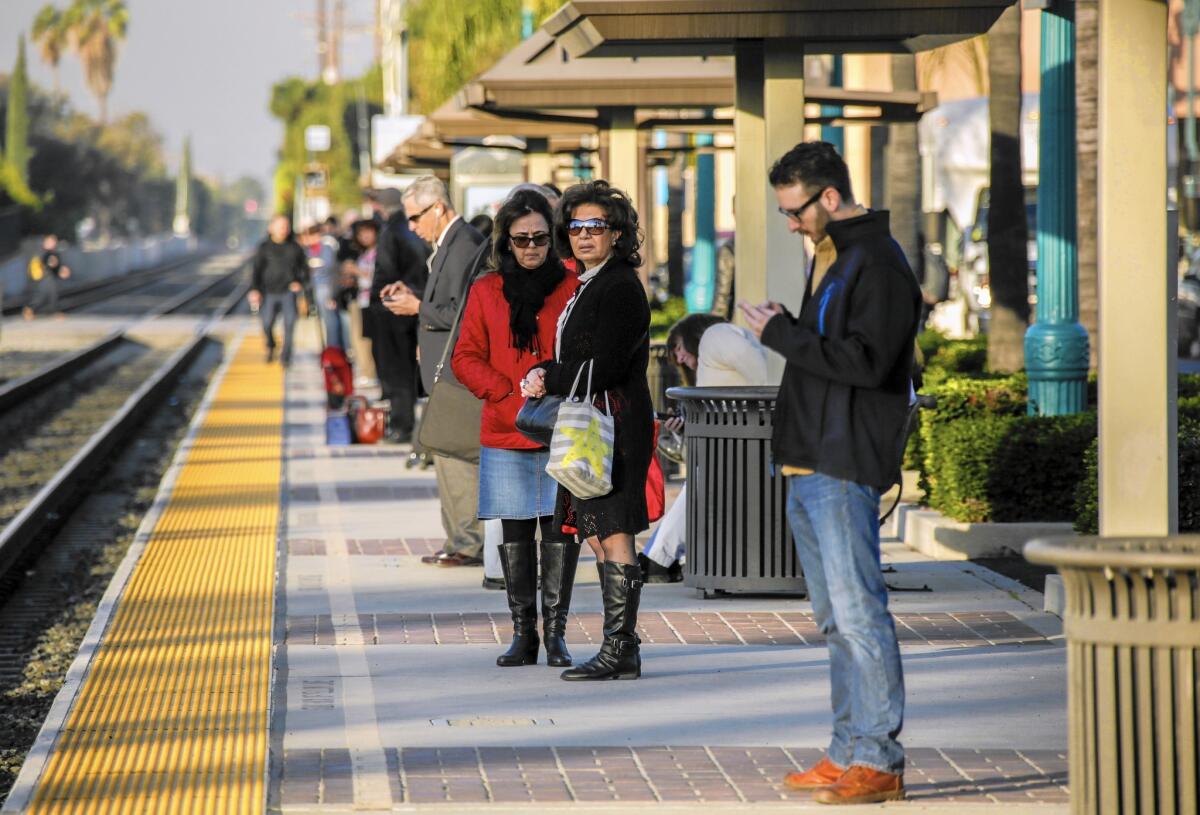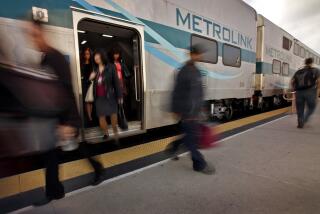Delays surged last year as Metrolink broke in a new system to prevent accidents

- Share via
Despite efforts by Metrolink officials to improve service, the number of late trains on Southern California’s commuter railroad nearly doubled last year, to the dismay of thousands of riders.
Delays surged from 2,382 in 2014 to 4,395 in 2015, with the sharpest increase occurring in August, when about 15% of trains were late compared with less than 7% the year before, according to Metrolink records.
Rail officials said a train is late if it arrives at a destination more than five minutes after its scheduled time. The railroad’s goal is an on-time-performance rate of 93% to 94%, a level that was never reached during the last six months of 2015.
“We knew we were going to have a rough year,” said Gary Lettengarver, chief operating officer for Metrolink. “Conflicts with freight trains plus track construction were problems. And we’re learning to use positive train control. This is a technology no one really knows about.”
Last year, Metrolink became the first commuter railroad in the nation to implement so-called PTC, a sophisticated system that relies on global positioning technology, computers and digital communications to monitor trains and prevent accidents by automatically slowing or stopping them in emergencies.
Rail officials said they are still fine-tuning the system to prevent it from unnecessarily stopping trains — a problem that resulted in 613 delays. Resetting the onboard equipment, they add, takes up to 20 minutes.
“We are one of the first railroads in the world to have positive train control,” said Art Leahy, Metrolink’s chief executive. “We have a learning curve, and we’ve had to debug the system.”
According to railroad statistics, other delays from operations problems, signal failures and malfunctions of grade crossing equipment more than doubled in 2015. Conflicts with a growing number of freight trains delayed 320 more Metrolink trains than in 2014.
See more of our top stories on Facebook >>
Bad weather, suicides, trespassers on the right-of-way and police activity accounted for an increase of 247 late trains. The number of delays caused by mechanical problems largely related to Metrolink’s aging fleet of locomotives jumped 26% to 588.
The surge in late trains comes as Metrolink is trying to rebuild ridership and overcome a number of customer service issues such as faulty ticket vending machines, unreliable engines and a lack of amenities for passengers.
The increase in delays also has come to the attention of an ad hoc regional rail committee recently established by the Los Angeles County Metropolitan Transportation Authority to evaluate Metrolink’s service. The transportation authority is the largest financial supporter of the commuter line.
On Jan. 20, committee members asked railroad officials to address the delays and develop a timeline for correcting the problems.
“Our concern is that people rely on the system and travel long distances on Metrolink. They need to pick up kids from day care. They need to get to work on time or risk getting fired. If they are consistently late, it becomes a major problem,” said Jennifer Brogin, an alternate committee member and transportation deputy for Los Angeles County Supervisor Michael Antonovich.
Metrolink officials said they are dealing with the delays and have created a team to visit commuter railroads elsewhere in the U.S. to study how they prevent and cope with late trains.
“We basically have addressed every major issue,” said Sherita Coffelt, a Metrolink spokeswoman. “We are not receiving the same level of complaints as before.”
Many of last year’s delays were on the San Bernardino line — one of the most traveled routes on the Metrolink system, which serves Los Angeles, Orange, Riverside, San Bernardino, San Diego and Ventura counties.
“It was awful. There were constant problems,” said Betty Jue of Lake Arrowhead, who took the line to reach her job at a law firm in downtown Los Angeles. “Trains were late all the time.”
Jue sent a letter to the Metrolink board, one of an estimated 2,000 complaints lodged with the railroad or posted on social media sites by unhappy riders. About 1,000 concerned late trains on the line, railroad officials said.
The San Bernardino situation was aggravated by overcrowded passenger cars that resulted from a schedule change in October, which removed a peak-hour train from the line’s schedule. To solve the problem, Metrolink added passenger cars to the remaining trains.
“The overcrowding was terrible,” Jue said. “By the time we got to Covina, it was standing room only. We were packed so tight you didn’t worry about falling.”
Adding to the delays, officials said, were unwarranted activations of positive train control, mechanical problems, operational issues and the use of slow freight locomotives to replace all 57 of Metrolink’s cab cars at the front of trains.
Cab cars are passenger coaches with an engineer’s post. They are normally placed at the front of Metrolink trains when they reverse direction at the end of a line.
After the Metrolink crash in February 2015 near Oxnard, the railroad decided to remove its cab cars from the lead position because of concerns about substandard front-end deflectors that are designed to keep debris and wreckage from getting under the wheels.
Rail officials said the large freight locomotives were used on the line for only 10 days in December. They proved slower than passenger engines, and their size, plus the added cars, increased the length of trains, complicating the unloading of passengers because they were too big for station platforms.
“We did make a mistake on the schedule change. We are correcting that,” Leahy said. “We are learning from our mistakes.”
Perhaps the longest delay last year occurred about 6 p.m. Dec. 30 after a Metrolink train struck and killed a pedestrian along the Antelope Valley Line between the Lancaster and Palmdale stations.
Railroad officials said problems with the Los Angeles County Sheriff’s Department in assigning units to the scene delayed a train by five hours and another by two hours. No buses were available to take the stranded passengers to their stations.
Since October, 83 out of 261 complaints filed by riders on the Antelope Valley Line concerned late trains.
Metrolink is now working with the Sheriff’s Department to rewrite procedures to ensure that law enforcement and coroner’s units can get to an incident quickly if they are needed.
“We had those poor people stuck on the train for five hours. It’s inexcusable,” Leahy said. “To have passengers unnecessarily subjected to delay is something that just can’t happen if we want to keep our riders.”
Twitter: @LADeadline16
ALSO
Firefighters tackle blaze at industrial plastics facility in Glassell Park
Department of Justice to investigate San Francisco Police Department
O.C. Sheriff’s Department examines what went wrong as fugitives return to jail
More to Read
Sign up for Essential California
The most important California stories and recommendations in your inbox every morning.
You may occasionally receive promotional content from the Los Angeles Times.











